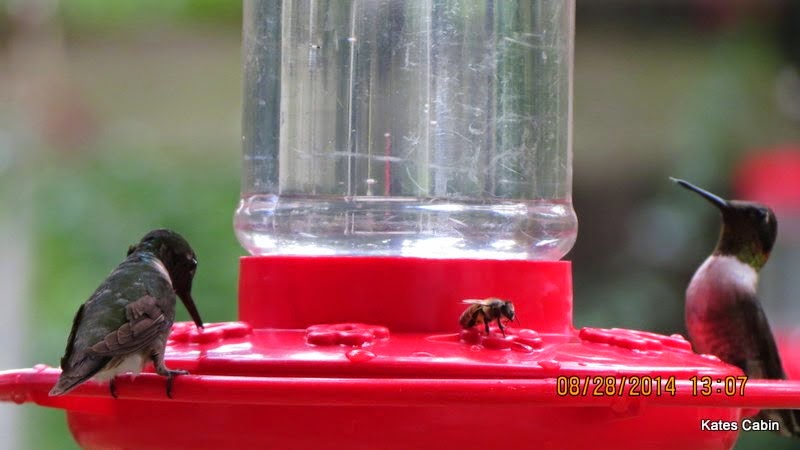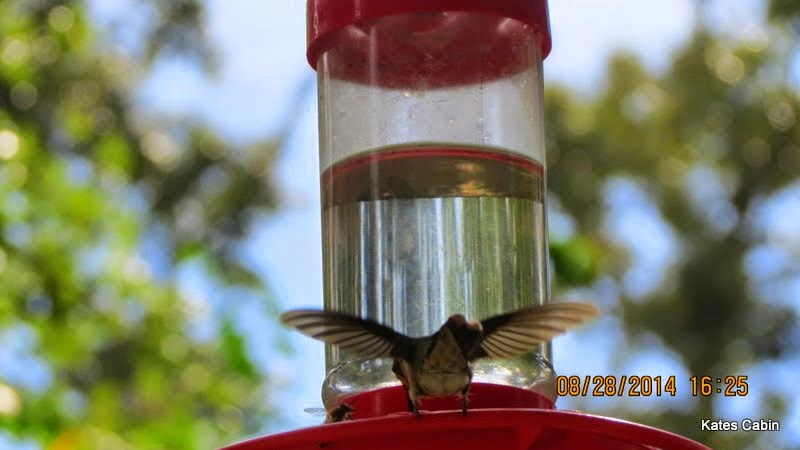
Hi Everybody!!
I think you will find the review photos of the Hummingbird Migration get more exciting as more birds come in and the competition heats up! Today's photos are from August 28. It is a delight for me to sit here at the outdoor table just witnessing the big picture. You will notice how the birds and bees compete for the sugar ports. Many thanks to Awesome Auto for taking a series of my pics and make them move in one image. You can get this for your photos in the G+ Photo Albums. Enjoy!

Link to complete photostudy in G+ Photo Albums:
https://plus.google.com/u/0/photos/117645114459863049265/albums/6065062958466901361

2 Adult Male Ruby-Throated Hummers having lunch together

They keep an eye on each other

Adult Female Ruby-Throated Hummingbird sucking up nectar

Looking around

Taking another long sip

Coming in unafraid of bee

Move over!




https://en.wikipedia.org/wiki/Competition
Competition
From Wikipedia, the free encyclopedia
Consequences[edit]
Competition can have both beneficial and detrimental effects. Many evolutionary biologists view inter-species and intra-species competition as the driving force of adaptation, and ultimately ofevolution. However, some biologists, most famously Richard Dawkins, prefer to think of evolution in terms of competition between single genes, which have the welfare of the organism 'in mind' only insofar as that welfare furthers their own selfish drives for replication. Some social darwinists claim that competition also serves as a mechanism for determining the best-suited group; politically, economically and ecologically. Positively, competition may serve as a form of recreation or a challenge provided that it is non-hostile. On the negative side, competition can cause injury and loss to the organisms involved, and drain valuable resources and energy. In the human species competition can be expensive on many levels, not only in lives lost to war, physical injuries, and damaged psychological well beings, but also in the health effects from everyday civilian life caused by work stress, long work hours, abusive working relationships, and poor working conditions, that detract from the enjoyment of life, even as such competition results in financial gain for the owners.
Biology and ecology[edit]
Main article: Competition (biology)
Competition within, between, and among species is one of the most important forces in biology, especially in the field of ecology.[3] Competition between members of a species ("intraspecific") for resources such as food, water, territory, and sunlight may result in an increase in the frequency of a variant of the species best suited for survival and reproduction until its fixation within a population. Competition is also present between species ("interspecific"). When resources are limited, several species may depend on these resources. Thus, each of the species competes with the others to gain access to the resources. As a result, species less suited to compete for the resources may die out unless they adapt by character dislocation, for instance. According toevolutionary theory, this competition within and between species for resources plays a significant role in natural selection. At shorter time scales, competition is also one of the most important factors controlling diversity in ecological communities, particularly in plant communities where asymmetric competition and competitive dominance frequently occur.[3]
The study of competition[edit]
Competition has been studied in several fields, including psychology, sociology and anthropology. Social psychologists, for instance, study the nature of competition. They investigate the natural urge of competition and its circumstances. They also study group dynamics, to detect how competition emerges and what its effects are. Sociologists, meanwhile, study the effects of competition on society as a whole. In addition, anthropologists study the history and prehistory of competition in various cultures. They also investigate how competition manifested itself in various culturalsettings in the past, and how competition has developed over time.
Competitiveness[edit]
Main article: Competitiveness
Many philosophers and psychologists have identified a trait in most living organisms which can drive the particular organism to compete. This trait, unsurprisingly called competitiveness, is viewed as an innate biological trait which coexists along with the urge for survival. Competitiveness, or the inclination to compete, though, has become synonymous with aggressiveness and ambition in the English language. More advanced civilizations integrate aggressiveness and competitiveness into their interactions, as a way to distribute resources and adapt. Many plants compete with neighboring ones for sunlight.
However, Stephen Jay Gould and others have argued that as one ascends the evolutionary hierarchy, competitiveness (the survival instinct) becomes less innate, and more a learned behavior.[citation needed] The same could be said for co-operation: in humans, at least, both co-operation and competition are considered learned behaviors[citation needed], because the human species learns to adapt to environmental pressures. Consequently, if survival requires competitive behaviors, the individual will compete, and if survival requires co-operative behaviors, the individual will co-operate. In the case of humans, therefore, aggressiveness may be an innate characteristic, but a person need not be competitive at the same time, for instance when scaling a cliff. On the other hand, humans seem also to have a nurturing instinct, to protect newborns and the weak. While that does not necessitate co-operative behavior, it does help.[citation needed]
The term also applies to econometrics. Here, it is a comparative measure of the ability and performance of a firm or sub-sector to sell and produce/supply goods and/or services in a given market. The two academic bodies of thought on the assessment of competitiveness are the Structure Conduct Performance Paradigm and the more contemporary New Empirical Industrial Organisation model. Predicting changes in the competitiveness of business sectors is becoming an integral and explicit step in public policymaking. Within capitalist economic systems, the drive of enterprises is to maintain and improve their own competitiveness.
(Please see link for complete article)
(Please see link for complete article)
















...this is brendasue signing off from Rainbow Creek. See you next time!


O+O

No comments:
Post a Comment